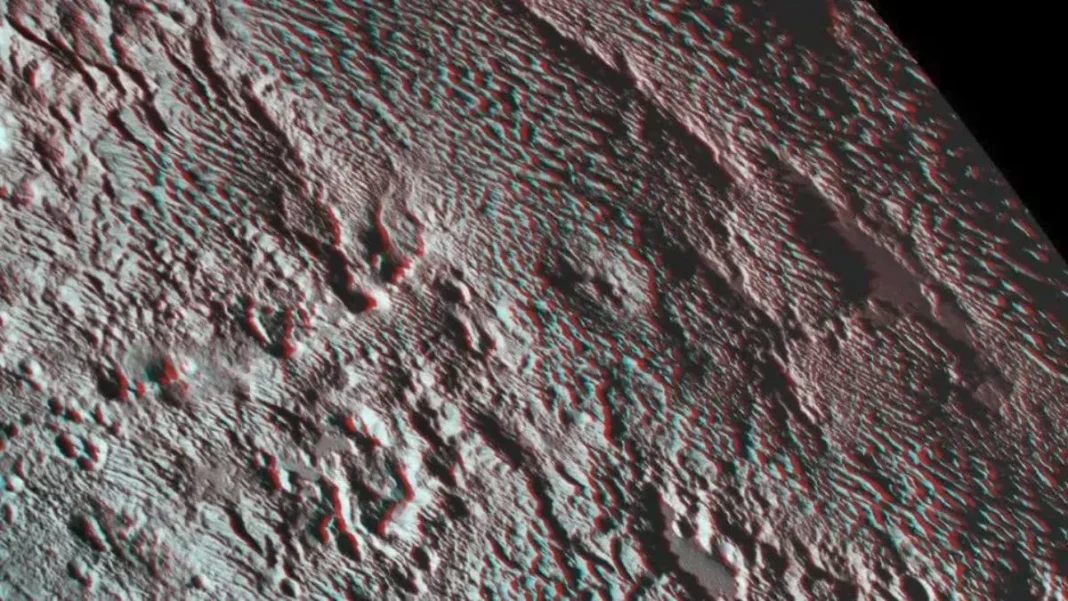New research has uncovered a fascinating discovery about the distant dwarf planet, Pluto. Data collected by NASA’s New Horizons spacecraft over a decade ago has revealed extensive bladed terrain made of methane ice. These towering spires, arranged in parallel rows, cover over half of the planet’s midsection, spanning an area five times the width of the continental United States. The findings, published in the journal Icarus, shed new light on the dynamic and ever-changing nature of Pluto’s surface.
The New Horizons spacecraft, launched in 2006, made a historic flyby of Pluto in 2015, capturing stunning images and data of this distant and mysterious world. Among the most intriguing findings were the presence of icy mountains, a heart-shaped glacier and a hazy atmosphere. However, it was the recent analysis of data collected by the spacecraft’s Long Range Reconnaissance Imager (LORRI) that has revealed the existence of this extensive bladed terrain.
The terrain, which covers an area of approximately 3,000 kilometers, is located in the northern hemisphere of Pluto. The blades, which are estimated to be around 500 meters tall, are believed to have been shaped by seasonal condensation and sublimation cycles. During the colder seasons, when Pluto is farther away from the sun, the methane in the atmosphere freezes and forms these towering structures. As the planet moves closer to the sun, the ice sublimates, or turns directly into gas, leaving behind these unique and intricate formations.
According to Jeffrey Moore, a planetary scientist at NASA’s Ames Research Center and lead author of the study, “These are quite spectacular features that we’ve never seen on any other icy worlds. While we expected to find some interesting surface features on Pluto, the discovery of this extensive bladed terrain was completely unexpected.”
The formation of these structures is a testament to the complex and dynamic nature of Pluto’s surface. With a surface temperature of -400 degrees Fahrenheit, Pluto is an incredibly cold and harsh environment. Yet, even in these extreme conditions, the planet’s surface is constantly changing and evolving.
The discovery of this bladed terrain has also raised questions about the composition of Pluto’s surface. The methane ice that makes up these structures is highly reflective, causing them to appear bright in images captured by the spacecraft. This has led scientists to believe that this region of Pluto’s surface is covered with a thick layer of methane ice, which may be masking other features that lie beneath.
While the exact nature and composition of this terrain are still being studied, scientists are excited about the potential of further exploration of Pluto’s surface. “This discovery shows that there is still so much to learn about this distant and enigmatic world,” says Moore. “We can’t wait to see what other surprises Pluto has in store for us.”
The New Horizons spacecraft is currently on its way to explore another distant object in the Kuiper Belt, a region of icy bodies beyond the orbit of Neptune. However, the data collected during its flyby of Pluto is still being analyzed, and scientists believe that there may be even more discoveries waiting to be uncovered.
The findings of this study not only provide valuable insights into the geology and climate of Pluto but also highlight the importance of continued exploration of our solar system. The New Horizons mission has proven to be a remarkable success, providing us with a wealth of knowledge and captivating images of a world that was once shrouded in mystery.
As we continue to unravel the secrets of Pluto and other distant worlds, we are reminded of the vastness and beauty of our universe. The discovery of this bladed terrain on Pluto is a testament to the power of scientific exploration and the endless possibilities that lie beyond our own planet. Who knows what other wonders await us in the far reaches of our solar system? The only way to find out is to keep exploring.


